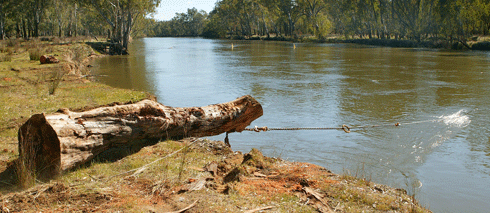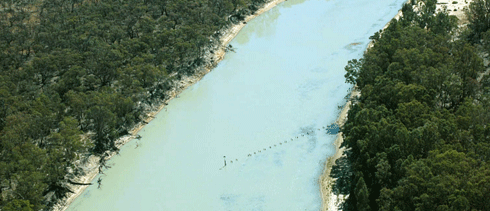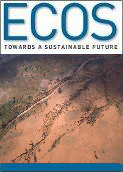
|
Published: 19 November 2012
Snags underpin Murray River restoration plan
Trees, branches and logs that have fallen into river channels provide critical structural habitat for river life. Over the past two centuries or so in Australia, such habitat has been removed for boat navigation, water conveyance and infrastructure protection. In 2003, the Murray–Darling Basin Authority began ‘resnagging’ a section of the Murray River to restore native fish habitat.

|
|
Towing a tree trunk into the Murray River: native fish species have been returning to the section of the river that has been resnagged. Credit:
Michael Bell/MDBA
|
Across the rivers of the Murray–Darling Basin, records indicate that several million trees were removed following European settlement. Contemporary studies on native fish in the Basin have identified this tree removal as a significant factor in the dramatic decline of native fish populations.
Consequently, the Murray–Darling Basin Authority (MDBA) started a project in 2003 to restore ‘structural woody habitats’ (SWH) along the 2500-kilometre-long Murray River to alleviate associated declines in native fish populations.
The project focuses on a 194-kilometre stretch of the Murray between Lake Hume and Lake Mulwala. Over 24,000 SWH were removed from this reach between 1976 and 1987; an investigation in 2004 identified only 5000 SWH remaining. Native fish surveys conducted at the same time identified low abundance of native fish in comparison to neighbouring and less disturbed reaches.
As a result, between 2004 and 2009, more than 4500 new ‘snags’ were reintroduced to this reach of the Murray River – part of the largest project of its kind undertaken in Australia.
While previous research has provided clear evidence that native fish will use restored in-channel woody habitats, it is unclear if such restoration will result in an increase in population (especially for threatened species), enhance distribution, or assist recreational fisheries objectives.
For example, does the process of in-stream habitat restoration increase the number of fish in a river, or does new habitat just act as a ‘honey pot’, localising already present fish without increasing total numbers.
Identifying and monitoring these criteria are important steps in aiding the recovery of fish populations, in line with the MDBA and Native Fish Strategy objectives. Understanding how woody habitat restoration helps achieve these objectives will enhance future investment in such restoration by MDBA and partner governments. Our data collection program is currently entering its seventh (and final) year.
Data collection includes electrofishing data to measure changes in Catch Per Unit Effort (CPUE) over time; passive tagging to inform mark recapture models (including survivorship); annual trials to determine electrofishing efficiency; a large radio-tracking program to determine immigration and emigration rates and yearly mortality; and a research angler program to determine angler CPUE. A comprehensive statistical model is being constructed to allow combined analysis of these various data sets.
Our early analysis has shown a trend for increasing numbers of key native fish species, such as Murray cod and golden perch, appearing in the reach that has been resnagged. Radio-tracking has also shown this section of the river to be a net ‘immigrator’ of fish – i.e. more radio-tagged have moved into the reach than have moved out of it – with the major ‘source’ of fish being Lake Mulwala.
Densities of two key threatened species, trout cod and silver perch, have also increased markedly along this reach. Further, during the last two years of the monitoring program, small numbers of one-year-old Murray cod have been detected – an important finding, given that the first four years of sampling failed to locate this age-group in the population.
What are the lessons arising from the project to date?
-
In rivers where bank stabilisation works are increasingly used – significantly reducing natural tree input to the river from eroding banks – the artificial introduction of snags needs to be incorporated into management plans.
-
When undertaking in-stream habitat restoration, detailed mapping must be carried out to identify longitudinal ‘gaps’ in snag density to increase the cost-benefit from expensive resnagging programs. For example, it is better to target an area of low habitat density located between two areas of higher habitat density, enabling habitat continuity.
-
Due to the long timeframes needed to measure population changes in long-lived, large-bodied native fishes, monitoring programs should be designed and funded over a timeframe that is likely to show significant biological responses.
-
When designing programs to reinstate in-stream habitat, managers should take into account other environmental factors. For example, although the statistical modelling is yet to be completed, observations by field teams working on the project show the further away native fish are from the impacts of Lake Hume’s fast-flowing, cold water, the more positive has been their response to resnagging. As resnagging is expensive, it is prudent to ensure the main limiting factor in the fish population is lack of habitat, rather than temperature or flow.
Jarod Lyon is a Senior Scientist (Fish Ecology), focusing on threatened species and habitat rehabilitation, at Arthur Rylah Institute for Environmental Research, Department of Sustainability & Environment, Victoria. This article first appeared in RipRap, the magazine of the Australian River Restoration Centre (ARRC) and has been republished with permission.





